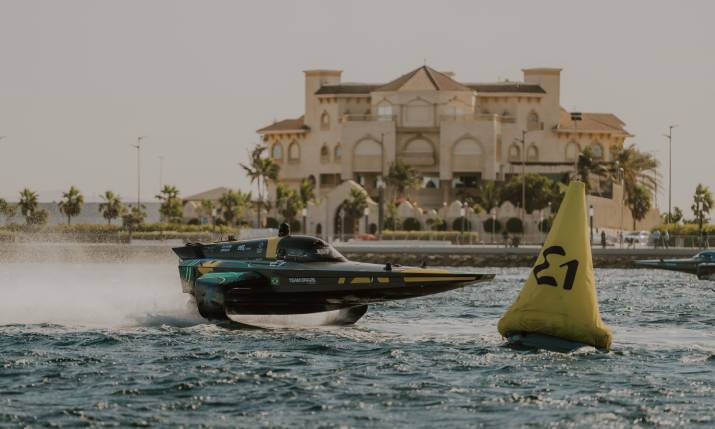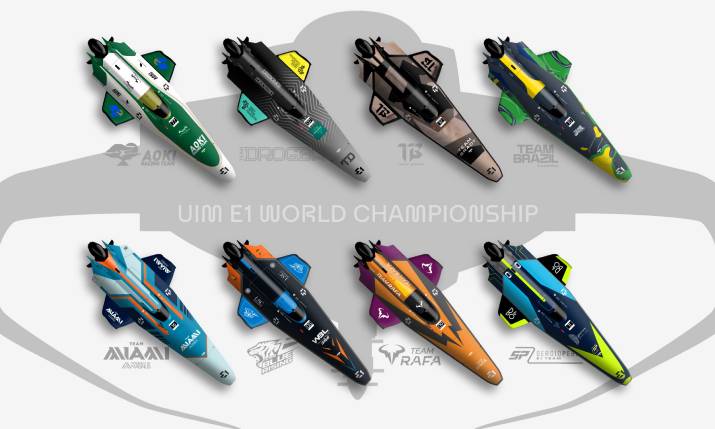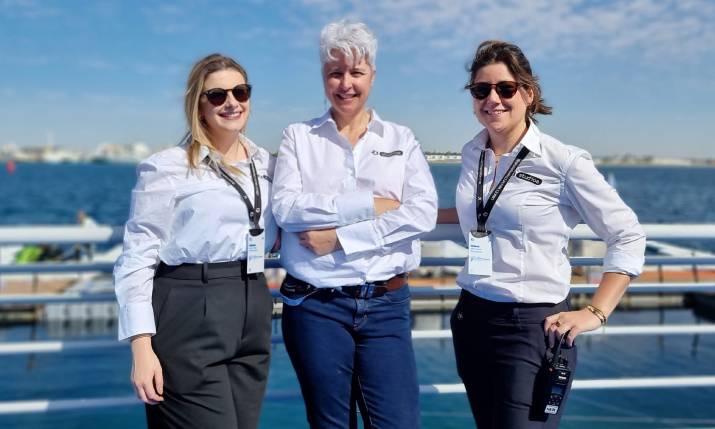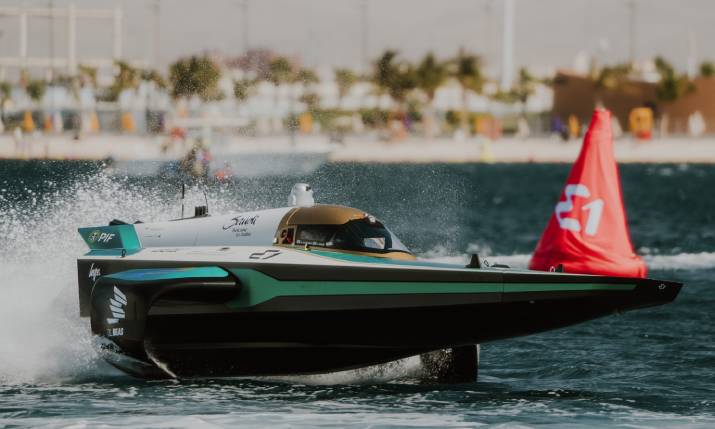Global launch: Aurora Media Worldwide on bringing the never-seen-before sport of E1 World Electric Powerboat Series to life

Aurora Media Worldwide has taken up the challenge of creating the Union Internationale Motonautique (UIM) E1 World Electric Powerboat Series broadcast from scratch
Creating a broadcast for a never-seen-before, brand new sport is no easy task. However, Aurora Media Worldwide has taken to this challenge once again with the Union Internationale Motonautique (UIM) E1 World Electric Powerboat Series, which took to the water for the first time at the beginning of February.
The creation of the first E1 broadcast took up much of 2023 for host broadcaster, Aurora. Lawrence Duffy, founder and CEO at Aurora, explains what went on during that period: “As most producers will tell you, when global launches like this happen or when major events happen, there’s so much work that goes on in the background before teams land on site or before hiring gets done, or before plane tickets get booked, or before even equipment gets commissioned.
“Understanding that tech stack, understanding all that with all the partners and all the interdependencies and understand the sport, and go to Jeddah and work with a machine on the water – which is amazing, which we hadn’t seen work before in a competitive environment before the first race – that is just a different technical level of sports production, which we’ve seen come on in the last 10 years”
“We knew a bit about how we’d cover E1, but really we were developing the coverage plan and particularly the graphics pack most of last year because, with a new sport like this, so much of it is about the data and the technology.
“We had to work out the course layout and the integration of the course layout, the boats themselves, the data on the boats, what data we required to be able to visualise the course and the competition, and then get to camera technology; what cameras and what graphics would we use. So that took us six to nine months to work all that out. At that point, we’re doing a paper exercise, and then we start commissioning, buying kit or renting kit and then we start to put it together.”

Aurora Media Worldwide put a massive effort into differentiating E1’s broadcast graphics from anything else out there
Tech stack
Duffy believes that productions today are better thought of as a stack of technology, as more and more aspects are put in the cloud and digitised. He says: “The market’s really changed in relation to how these shows get made. This is what I describe as a tech stack; we called it layering before, but really it’s a tech stack; you’ve got land cameras, you’ve got long lenses, you’ve got RF cameras, you’ve got on-board cameras and you’ve got special cameras, and you’ve got drones. And then on top of that, you’ve got more standard sporting graphics which carry data.
“Then you’ve got augmented reality (AR), then you’ve got virtual reality (VR), then you’ve got audio from the water, audio from the athletes which allow them to talk to shore,” he goes on. “Then you’ve got music effects on top of that. And then on top of all that, you’ve got remote production, which is all done pretty much with signals sent in the cloud.
“Understanding that tech stack, understanding all that with all the partners and all the interdependencies and understand the sport, and go to Jeddah and work with a machine on the water – which is amazing, which we hadn’t seen work before in a competitive environment before the first race – that is just a different technical level of sports production, which we’ve seen come on in the last 10 years,” continues Duffy. “We’re not the only people to do it and to understand it, but I think we have an MO that is required for that level of sophistication, for that level of championship.”
Blank slate
Aurora came at E1 with an almost blank slate regarding water sports; previously Aurora’s water-based sport projects included SailGP, which it joined after the production was designed and set up, and in a previous life Duffy worked on America’s Cup content and the Volvo Ocean Race.
Duffy notes: “So I’d done water in my career, but to be honest with you, the world’s moved on so much that Aurora had to be super diligent about just everything in relation to the boat. Mark Sheffield, who is broadcast and innovation director for E1, his knowledge was really important to us in the beginning.
“There’s a sort of a brain’s trust in the beginning of what cameras would we need, what technology could we use, how did the boat operate and what was the optimisation of what we’re trying to achieve from a broadcast point of view. Mike’s [Scott, Aurora executive producer] background in motorsport, having launched Formula E and Extreme E, was so appropriate to this as well because of the layering of the media product. So it was really a super-sophisticated build.”
Remote complications
As with its work developing another start up, Extreme E, Aurora decided that the best plan for the E1 broadcast was remote production, given the complexity of what it wanted to achieve technically as well as from a sustainability perspective, which is a key pillar for E1 and important to Aurora as well.
Duffy explains: “We made it even more difficult for ourselves by deciding to be remote straight out of the box. We only did that because we’d had the experience of being remote successfully for Extreme E, and we thought we could broadcast from anywhere in the world, which we can. But we would never have taken this into the remote world had we not had the positive experience with Extreme E.
“Even late in the day, there was a debate about would it be safer to have trucks on site, but if you have trucks on site or a flyaway on site, we didn’t think we could use the NEP graphics pack we were planning on in the same manner. So we decided to go for it and just do everything remote, and it came off,” says Duffy.
“You’ve got to expect the unexpected, but you’ve got to have confidence that you’ve pretty much chosen the right things on paper… but you’re still hoping that your choices are the right choices”
Following a tender, Aurora chose Presteigne Broadcast Hire, which built an end-to-end gallery and production space in Crawley, UK specifically to bring the remote production of this project to life, as well as freighting and engineering the broadcast set up and cameras to Jeddah for race one.
Duffy says that a prosaic challenge for this project was choosing a new partner, but it was a success. He explains: “We decided to work with Presteigne Broadcast Hire, who, I have to say for the record, were sensational to work with. They built a brand new studio in Crawley as an end-to-end remote production facility, which was quite bold actually. We have had very good experiences with Timeline, Gravity and NEP, and now we’re working with a fourth company who had decided that remote production was something they wanted to be involved in.”
Aurora executive producer on E1, Mike Scott, adds: “I think it was the fourth time that we were the first people to use [brand new] remote galleries [from a tech provider]. So we were the first in Timeline’s new facility, we were the first in Gravity [at Westworks]. We were the first in Grays Inn Road with NEP, and then the first with Presteigne. So it’s quite a thing in a way to keep on doing this over again, but it gets easier each time, I find!”
Duffy adds: “When you get into remote production, it’s really about what you can achieve on site and then what you can achieve back in wherever your centralised production is. We had confidence [Presteigne] could do both, and they were ready to go.”

Aurora staff on location in Jeddah for the first E1 race included [L to R] production manager Kelsey Gallagher, Laura Watts executive producer, and technical producer Emily Merron
The major challenge of this production was that it was a brand new sport that is quite unlike anything else, which meant Aurora had to stretch the imagination of its collective team to develop the plan.
Duffy explains: “I think a start up is just so hard. The challenges are not one thing independently; as with Formula E and Extreme E, we weren’t so familiar with the boats, we didn’t know what the boats were capable of doing. We hadn’t really seen a competitive race between the boats in the same way as we hadn’t really seen a competitive race between the cars in Formula E or Extreme E. So from a narrative point of view, we didn’t really know what we were going to get, number one.
“Number two, even with some of the best brains I think, or some of the best experience, we didn’t really know if we had the camera inventory and the graphics inventory correct. We hadn’t really seen all of it come together.
“And there is, frankly, a nervousness, even from people with the wealth of experience, of “is it all going to pull together?”. Because of the nature of the way we and the way the industry at this level operates now, so much of this is done in the cloud. You’ve got a graphics team in the Netherlands, which we’re familiar with. We’ve got onsite, onboards and agile cameras, and drones in Jeddah. It’s not like working in Southampton. And then we’ve got a new facility in London with all the signals coming in remotely.
“And then we’re working on a new sport, albeit with great partners like Alkamel as well [a specialist in timing, data processing, connectivity, and graphics] who we’d worked with before on data and timing, plus Cross Shore Media for a new onboard camera and NEP for graphics. When you pull all that together, you’ve got to expect the unexpected, but you’ve got to have confidence that you’ve pretty much chosen the right things on paper… but you’re still hoping that your choices are the right choices.”
Scott goes on: “I think that was the biggest challenges; all these different parties, all doing their individual thing, and you’ve got to gather all these strands together, and somehow we have to root them and make something out of that all at the same time. That’s the hardest part I’d say. But that’s the fun bit.”
The team pulling this host broadcast together were Aurora’s executive producers Laura Watts and Scott, director Ben Spencer, technical architect and, according to Duffy, “all around brain” David O’Carroll, plus Danny Koelewijn, head of creative graphics at NEP The Netherlands, Presteigne Charter project manager, Mick Bass and unit manager, Simon Atkinson, as well as E1’s Sheffield and head of content at E1 Laurence Boyd.

Join E1 for its second race in Venice, Italy on 12 May
Hot moments
As to how race one went, Duffy says: “It went really well. Typically, we had some challenges around getting all the data points that we needed on some of the testing. But when we were broadcasting to the world, it all, goodness, it all went very well!
“There were some hot moments where you are asking yourself, “have you done the right thing? Wouldn’t it just have been easier to bring a truck?”,” Duffy goes on. “But you wouldn’t have got the level of output sought by the stakeholders and us. To do that you’ve got to take some calculated risks and you’ve got to think, “can our partners deliver this pretty ground-breaking technology on the water in this championship?” And the answer is yes, they can.
“Now, we want to go further, but it takes a while,” Duffy ponders. “This development phase just takes a while and it’s not easy. When we see the shows go to air, it’s gratifying. But the journey to get there is very complex and can be stressful. You’ve got to choose the right weapons.”
Adds Scott: “Race day was the easiest day of the week. Isn’t that how it should be? So that was actually, “oh, we’re making telly now,” which is great. It was super in the end.”
Continues Duffy: “Another nature of start-ups is even though you never get to perfect, what you do want to get to is repeatable. You have to make it consistent. I think that’s what we want to get to next so that we take the successful learnings of Jeddah, and the next stage is to make it repeatable, which I think we can do, and then to go again on the next component. We just have to do two or three [races] to make sure that everything we’ve done in Jeddah is consistent, that we can make it work all over again. So the journey, is really just started. We’re happy with what we’ve done, but there’s much more to do.”
Scott says there is now a list of things he would like to add to subsequent races. He explains: “Obviously there’s a million little things that we still think, “oh, that could be a little bit better, that could be a bit bigger, we didn’t have that graphic and that would be helpful…”. Once you’ve done an event, you have a list. You see things that you’d like to explain better or more. But I think the next big leap, tech-wise, is we’re trying to do the AR off a drone flying around, following the boats, as well as on a fixed position camera, which has got a whole world of pain [associated with it] because it’s not a helicopter. The drones have only got certain payloads and they move around a bit. But we’re trying to do that. We’ve had a wee bit of success doing that in the past, but I think to do it over water would be mega. So that’s our next level. We’ll try and do it for race two,” he concludes.
E1 is distributed across 30 global broadcasters including CBS US, ITV, Supersport, SSC Saudi Arabia, Disney/Star Sport India, Tencent China, Eurovision (EBU), Sky Italia, Ziggo NL, Fox Mexico, TV Globo Brasil and more.
E1 race two takes place in Venice on 12 May 2024

